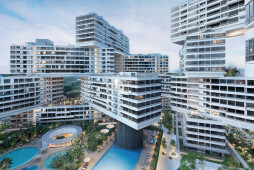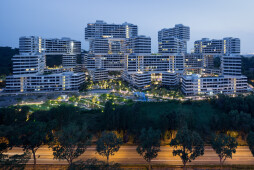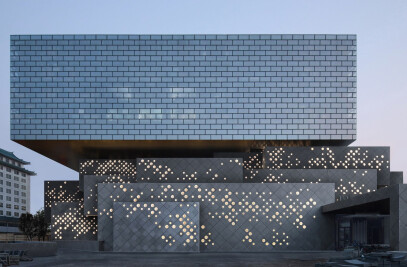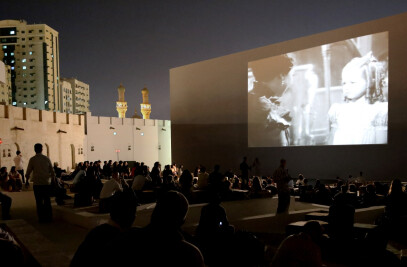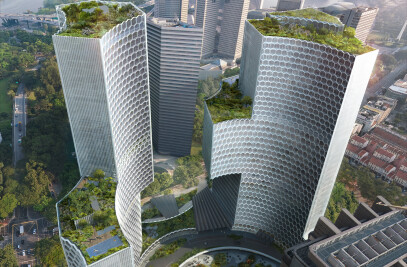The Interlace presents a radically new approach to contemporary living in a tropical environment and is one of the largest most ambitious residential developments in Singapore’s history. Instead of following the default typology of housing in Singapore – clusters of isolated, vertical towers – the design generates an intricate network of living and social spaces integrated with the natural environment.
The vertical is turned horizontal: 31 apartment blocks, each six stories tall and 70 meters long, are stacked in hexagonal arrangements around eight large-scale open permeable courtyards. The interlocking blocks create a multitude of shared and private outdoor spaces on multiple levels.
The blocks are arranged on four main ‘Superlevels’ with three ‘peaks’ of 24 stories. Other Superlevel stacks range from 6-18 stories to form a stepped geometry, resembling the dramatic topography of a landscape more than a typical building. Multi-story openings allow light and air to weave into the architecture and through the landscape of the courtyards. The 170,000m2 development provides 1,040 affordable residential units of varying sizes, with multidirectional views over the parks, courtyards, city, and sea. Sustainability features are incorporated throughout the project through careful environmental analysis and integration of low-impact passive energy strategies.
COMMUNITY : The Interlace generates ample spaces and opportunities for social interaction and shared activities while also providing intimate spaces of privacy and quietness – simultaneously fostering a sense of community and maintaining individuality and privacy. The notion of community life within a contemporary village is emphasized throughout the project by an extensive network of communal gardens and spaces. A variety of public amenities are interwoven into the lush vegetation, offering multiple opportunities for social interaction, leisure and recreation.
Multiple swimming pools and sun decks, children’s playgrounds, barbecue areas, spa gardens, performance spaces, and other amenities are situated within landscaped areas, are integrated with the outdoors and offer a wide selection of communal activities for residents. A continuous loop around the site, which invisibly doubles as the fire truck access, provides a 1km running track and connects the ‘internal’ courtyards to the activities around the edge of the site. SPACE Eight courtyards and their individual landscape are defined as the heart of the project and form distinct spatial identities within the surrounding stacks of the building blocks.
The primary pedestrian route through the project leads residents from the main entrance through and to the courtyards as primary points of orientation and identification – you live in a courtyard, a space, rather a building or an object. Pedestrian circulation is grouped and bundled according to the density of residents around each courtyard in a central ‘connector’. A system of secondary footpaths brings residents on the most direct route from the connector to the front doors of their homes.
The unusual geometry of the hexagonally stacked building blocks creates a dramatic spatial structure. Partly resting, partly floating, the blocks hover on top of each other to form open, permeable courtyards that interconnect with one another and the surrounding landscape and city. An expressive, interlaced space emerges that connects the multiple parts of the development into an open, inclusive community.
COMPACT CORES: A system of three core types for 6, 18, and 24 stories is located at the overlap of the stacked apartment blocks. Cores typically serve 3-4 different units per floor, which provides efficient circulation without long corridors. Core lobbies are naturally lit and ventilated, bringing daylight and fresh air into common areas. Circular “mega-columns” arranged around the vertical circulation in an optimized hexagonal configuration enable the 3-way rotation of the blocks and provide a standard solution for all conditions.
AFFORDABIITY : The highly efficient system of compact cores, minimal circulation, and maximized floor area allowed the project to be realized on a budget for affordable housing, within the competitive context of Singapore’s market. NATURE A series of site specific environmental studies were carried out and evaluated (wind, solar and daylight analysis) to determine intelligent strategies for the building envelope and landscape design. Early and comprehensive incorporation of low-impact passive energy strategies allowed the project to be given Singapore’s Green Mark Gold Plus Award. All apartments receive ample levels of daylight throughout the day while the unique massing of the project provides a sufficient level of self-shading in the courtyards which helps maintain comfortable outdoor spaces year-round and continuous usage of the courtyards and their communal functions.
Water bodies have been strategically placed within defined wind corridors. This allows evaporative cooling to happen along wind paths, reducing local air temperatures and improving the thermal comfort of outdoor recreation spaces in strategic micro-climate zones. Extensive balconies and protruding terraces form a cascading vertical landscape across the facades and further connect the green roofs and shared public terraces between the building volumes. Overall, the project appears not only surrounded by the tropical vegetation but embedded within it. All traffic and parking is accommodated in a single layer below the landscaped ground level. A large number of open-air voids allow light and air to the semi-sunken parking deck, creating areas of lush vegetation and trees below ground and connecting these spaces visually and through planting to the courtyards above.
The landscape design capitalizes on the generous size of the eight-hectare site and further maximizes the green area and presence of nature. By stacking the apartment blocks, the design has generated additional horizontal surfaces and thereby the opportunity for extensive roof gardens and numerous landscaped public terraces that in aggregate provide even more overall green area than the size of the unbuilt site.

